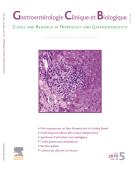Hépatite virale B et Grossesse - 29/07/08
Résumé |
Chez la femme enceinte, l’infection par le virus de l’hépatite B (VHB) est dominée par le risque de transmission mère-enfant (transmission verticale). Le nouveau-né contaminé va rester le plus souvent porteur chronique. Cette transmission mère enfant peut être évitée grâce à la sérovaccination du nouveau-né. La recherche de l’antigène HBs (AgHBs) doit être effectuée chez toutes les femmes enceintes et, en France, ce dépistage est obligatoire lors de l’examen du 6e mois. Tous les nouveaunés de mères porteuses de l’AgHBs doivent bénéficier d’une sérovaccination contre le virus de l’hépatite B. La première injection de vaccin et une injection de gammaglobulines anti-HBs (100 ou 200UI) sont effectuées dès les premières heures de vie, par voie intramusculaire, dans deux sites différents. La vaccination est ensuite poursuivie selon le protocole recommandé. Bien que la sérovaccination du nouveau-né soit très efficace pour prévenir le portage chronique chez l’enfant (efficacité >90 %), des enfants peuvent être contaminés en particulier lorsque la charge virale est très élevée durant la grossesse. Chez ces femmes ayant une charge virale très élevée, la place d’un traitement par lamivudine en fin de grossesse dans le but de diminuer la charge virale et le risque de portage chronique chez l’enfant n’est pas encore clairement définie. L’efficacité de la sérovaccination doit être contrôlée chez tous les enfants par un examen sérologique (AgHBs et anticorps anti-HBs) effectué à distance de la dernière injection vaccinale. Les enfants porteurs de l’AgHBs doivent être examinés par un pédiatre ayant l’expérience de cette pathologie. La mise en évidence de la positivité de l’AgHBs chez une femme au cours de sa grossesse justifie un avis spécialisé et une enquête sérologique (AgHBs, anticorps anti-HBc, anticorps anti-HBs) systématique dans l’entourage familial.
Il testo completo di questo articolo è disponibile in PDF.Abstract |
In pregnant women, hepatitis B virus (HBV) infection presents the risk of mother-to-child (vertical) transmission. The contaminated newborn most often remains a chronic carrier. Mother-to-child transmission can be avoided by serovaccination of the newborn. Screening for HBs antigen is essential in all pregnant women; in France, it is mandatory at the 6-month prenatal examination. All infants born to mothers who are carriers of HBs antigen must receive a serovaccination against this virus, by intramuscular injection of vaccine and of hepatitis B immune globulin (H-BIG, 100 or 200 IU), in two different sites, in the first hours after birth. Vaccination then continues, according to the recommended protocol. Although the combination of vaccination and H-BIG is very effective in preventing chronic carriage in children (efficacy >90 %), some children may nonetheless be contaminated, especially when the viral load is very high during pregnancy. These women with very high viral loads may receive lamivudine treatment at the end of pregnancy to diminish viral load and thus the risk of chronic carriage in the child; however the role of this drug in this situation is not yet clearly defined. The efficacy of the serovaccination must be confirmed in all children by a serologic examination (HBs antigen and anti-HBs antibodies) at some time after the last vaccination. Children carrying the HBs antigen must be seen by a pediatrician who has experience with viral hepatitis. When HBs antigen is found in a woman during pregnancy, a specialist should be consulted and the family should undergo complete serologic testing (HBs antigen, anti-HBc and anti-HBs antibodies).
Il testo completo di questo articolo è disponibile in PDF.Mots clés : Hépatite virale B, Grossesse, Transmission mere-enfant
Keywords : Hepatitis B, Pregnancy, Vertical transmission
Mappa
Vol 32 - N° 1P2
P. 12-19 - Gennaio 2008 Ritorno al numeroBenvenuto su EM|consulte, il riferimento dei professionisti della salute.


